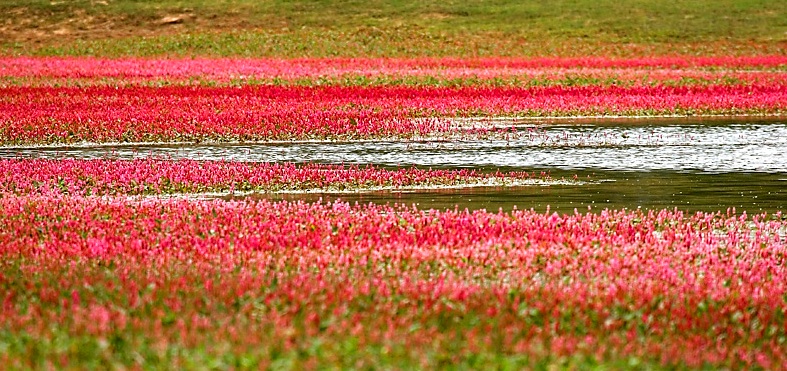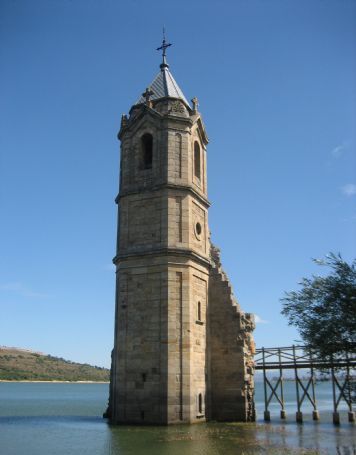
A short distance from Fontibre, where the Ebro River begins its long journey to the Mediterranean, today a large body of water extends: The Ebro Reservoir or Arija Reservoir Since the mid-twentieth century the waters of the Ebro, which occupy this space between Burgos and Cantabria, they are regulated and have formed an environment of great environmental value, which led to their declaration as a National Waterfowl Refuge.
The small villages located on the banks of the swamp form one of the most picturesque landscapes, often covered by snow, where it is easy to see horses grazing or numerous species of birds.
The area is a natural and scenic landscape of enormous wealth, ideal for all types of adventure sports, in addition to having the only ski station in the region, Alto Campoo.
The aspect is that of a large lake that stretches from east to west along 22 km., Surrounded by meadows, oak forests and mountains.
The best way to know is to make a route by car (motorcycle, bike or walking) bordering the entire swamp. They are about 60-70 kilometers.

To see the map, the situation and the state of the swamp, visit this website:
http://www.embalses.net/pantano-221-ebro.html
We start from Bezana towards Santander, in Cillerueo de Bezana, we turn off towards Arija (area of beaches, baths and water sports). The current church, dating from the sixteenth century, has three naves and beautiful ribbed vaults. Presumably its construction meant the abandonment and ruin of the old Romanesque church, whose remains can still be seen in a house in the upper neighborhood.
From here we continue bordering the swamp, the first town to enter Cantabria is Bimón, from where you can see magnificent views of the Ebro reservoir. The parish church, quite renovated, retains covers of the sixteenth century.

Following the road we arrive at Llano, a village located at 847 m altitude. Of its patrimony they emphasize a good parish church of century XVII, done in stone of masonry and with decorated cover. Next to it grow a monumental yew and beech.
Continue and past Renedo we find one of the best-known pictures of the municipality, the tower of the vanished church of Villanueva that emerges from the waters of the reservoir, today only the bell tower remains standing. The image of the tower surrounded by the waters is typical, and has received the name of the fish cathedral. The church was built around 1890, with the arrival of the La Robla railway.
The stones were brought from a quarry nearby, in La Riva, the stones of the foundations, about 500 kios each, were lowered into “Corzas” dragged by oxen. “Corzas” are a kind of wooden armor or sledges to carry large weights, such as stones or trunks. When the reservoir was built seven villages of this municipality and of Campoo de Yuso were flooded. The Tower of three heights with an octagonal shape and built in ashlar stone, can be seen when the water level drops. They have recently been rehabilitated and with a walkway you can visit the interior.
We continue until we reach Arroyo and we cross the dam. And immediately we will find a detour to the left that leads us to the Sanctuary of Montesclaros, which is located at a height of 950 meters above sea level. The Monastery of Our Lady of Montesclaros, baroque-mountain of the seventeenth, houses the patroness of Merindad de Campo, which arouses great devotion in the area. It was built, from a rock church and retains an altarpiece of the XVIII. The monastery lodges a cave, cave of the Virgin, in the bottom of its facilities, that could have been habitat of hermits from the origins of the Christianity in the zone. In an adjoining cave, there is an altar of the ninth century.
We will return to the swamp road towards Reinosa and we arrive at Retortillo where the Roman ruins of Julióbriga stand out, one of the main Roman settlements present in the Cantabrian territory.
The remains were declared of Cultural Interest in 1985. Next to the vestiges of the ancient Roman city is the Domus, a center of interest built according to the elevation of one of the villas that stood in Juliobriga.
Also in Retortillo is the Romanesque church of Santa María, a temple of the 12th century, declared an Asset of Cultural Interest in 1993. The ruins barely give a glimpse of what was the largest and most important Roman city in Cantabria. It is estimated that the excavations only allow us to admire five percent of what was a city of at least 20 hectares. At present, the village of Retortillo is built on the ruins.
We continue to Reinosa, which is the administrative and economic center of the Campoo-Los Valles district. The facades of the building of “La Casona” and the parochial Temple of San Sebastián are assets of cultural interest, within the category of monument.
We return to Corconte on the CA-171 road. Corconte houses the “Interpretation Center” of the Ebro Reservoir in the building of the old schools. It contains the original models of Engineer Manuel Lorenzo Pardo, the engineer who designed the Pantano in 1913. The Corconte spa, which already belongs to Burgos, where we can enjoy the spa services or simply have a coffee, as it is worth visiting.
We will arrive at a crossroads, we will take Burgos direction by the national road 623 and we will finish again in Bezana.
Lovers of ornithology should know that it is a protected natural space with the figures of LIC and ZEPA
